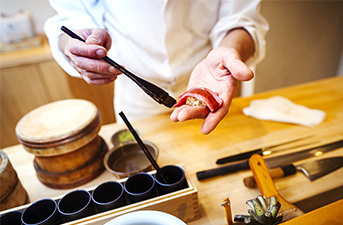Traditional Japanese / Kaiseki / Kappo Restaurants(552)
Ukihashi (Hotel Granvia Osaka)
Inspired by the Japanese literary classic the Tale of Genji, the Hotel Granvia Osaka’s Ukihashi provides an unforgettable dining experience with seasonal ingredients and beautiful decor.
Kitashinchi Okurano
Recommended by the Michelin Guide, Kitashinchi Okurano brings kaiseki cuisine to life by merging tradition with playfulness. Learn precisely what the philosophy of “wakei seijaku” means while experiencing culinary excellence in Osaka's heart.
Rokujo Kawarain San
Storytelling, tradition, and artistry underpin meals at Rokujo Kawarain San, a top-tier kaiseki venue with reasonable prices and seasonal menus.
Shirayuki
One of Fukuoka’s most celebrated kappo restaurants, Shirayuki’s chef is dedicated to helping guests discover the beauty of Kyushu seafood by through seasonal fish dishes. Sake and wine pairings are abundant.
Yugyoan Tankuma Kitamise (Hotel New Grand Yokohama)
Located inside the Hotel New Grand Yokohama, famed Kyoto restaurant Yugyoan brings its brand of Kyoto-style cuisine to Kanto. Here, guests can enjoy both sushi and kappo-style cuisine that’s a treat for both the eyes and taste buds.
Azabu Amishiro
Kyoto-style home-cooking comes to fashionable Azabu-Juban. Daily-changing menus feature seasonal vegetables, as well as meat and fish grilled over kishu-binchotan charcoal. Enjoy your meal with your pick from a wide range of sake.
Beppu Hirokado
Step out of the relaxing hot springs and into Hirokado for a food experience that is uniquely Oita. Enjoy an exclusive omakase course highlighting the region’s specialty produce, accompanied by handmade soba and delectable drinks.
Kitashinchi Mitsutoki
A splendid interior, creative presentation, and thoughtful customization set this Osaka restaurant apart from the highly competitive Kitashinchi eatery scene.
Nihonryori Byakuya
Nihonryori Byakuya isn’t content to stick with old ways of thinking and cooking. Set on the trendy Kagurazaka Street in Tokyo, this restaurant creates invigorating dishes based on the foundations of traditional Japanese cuisine.
G -WA Selection- (Tokyo Marriott Hotel)
Billed as authentic Japanese cuisine with a French twist, the Tokyo Marriott Hotel’s G ~WA Selection~ feels just as sophisticated as its name thanks to its stylish treatment of Japanese classics in a luxurious space.
Jikishinbou Saiki
At this kappo restaurant near Yasaka Shrine and the iconic Kiyomizu-dera Temple in Kyoto, elegance and traditional Japanese aesthetics meet to create dishes guaranteed to awaken all five senses.
Chakaiseki Zushi
Inspired by both daily and ceremonial meals of old, the chef of this chakaiseki restaurant manifests pre-Edo period dining philosophies to serve his guests a traditional culinary experience steeped in tea and tradition.
Kyoto Tsuruya (Nagoya Marriott Associa Hotel)
A dedicated sushi counter promises authentic dining, while course menus and celebratory meals bring people together from across the country and world to delight in historic Japanese traditions of hospitality.
Shion
Even before moving to its current Akasaka location, a philosophy of reverence for Japan’s natural beauty has always driven the traditional kaiseki cuisine at Shion. Private rooms provide a much-needed respite from the Tokyo rush.
Shunsai Hayato
Cuisine fit for a king. Near the Korakuen Gardens, this Okayama restaurant keeps the cuisine of the feudal lords of fine otonosama-ryori alive. Feast on fresh sashimi and Chiya beef, a wagyu cattle so rare it bears the title of “phantom wagyu”.
Minokichi Shinsaibashi Midosuji
The best of seasonal Kyoto-style cuisine rightfully enjoyed in traditional, folk-craft-filled dining rooms.
Hakata Sushi Takayama
Few culinary pairings capture harmony as beautifully as kaiseki cuisine and Edomae sushi, a blend mastered at Hakata Sushi Takayama.
WARAYAKI funsista
Tradition meets change at this Gotanda restaurant, where seasonal fish, meats and vegetables are grilled over straw in traditional Kochi style. Ingredients are seared with intense but carefully controlled heat to bring out a delightful, smoky aroma.
Ginza Hakobune Daiginjyo SHIZUKU
The reputation of this Ginza venue primarily rests on its impressive 500-plus sake library, enhanced by the allure of a private dining experience and teamed with Hokuriku-Shinetsu-inspired seasonal kaiseki that stands on its own merits.
Minokichi Takeshigero Hotel Granvia Kyoto
The Hotel Granvia Kyoto plays host to one of Kyoto’s most historic kyo-kaiseki restaurants, with over 300 years of history serving freshwater fish and other traditional dishes.
Ono
After years of operating his elusive traveling restaurant, the Michelin-starred chef Ono Koto has finally settled into a permanent home in the Kitashinchi district to deliver kaiseki using Awajishima-sourced items.

Ginza Shinohara
Leaving his life in Shiga behind, Chef Shinohara Takemasa moved to Tokyo to bring the taste of the Kansai country to Tokyo, and ended up winning two Michelin stars for his efforts.

Ogata
Kimono-shop-turned-restaurant serving an enticing blend of old and new, with two Michelin stars.

Mizai
One of the best Japanese restaurants in the world, in the serene setting of Kyoto’s cherry blossom park.

Kohaku
Chef Koizumi Koji is the youngest chef in Japan to hold three Michelin stars. At his Kagurazaka restaurant Kohaku, he uses unorthodox combinations of ingredients not usually found in traditional kaiseki to phenomenal effect.

Seizan
Inventive kaiseki dining, with a focus on exquisite soups.

Makimura
This restaurant may no longer have its astounding three Michelin stars, but it's definitely not due to lack of ability or deliciousness. Now referral-only, Makimura continues to delight regulars with its simple kaiseki cuisine.

Kagurazaka Ishikawa
Chef Ishikawa Hideki may be the owner of several Michelin-starred restaurants, but his first independent kaiseki restaurant, the three-Michelin-starred Kagurazaka Ishikawa, will always remain foremost in his heart.
